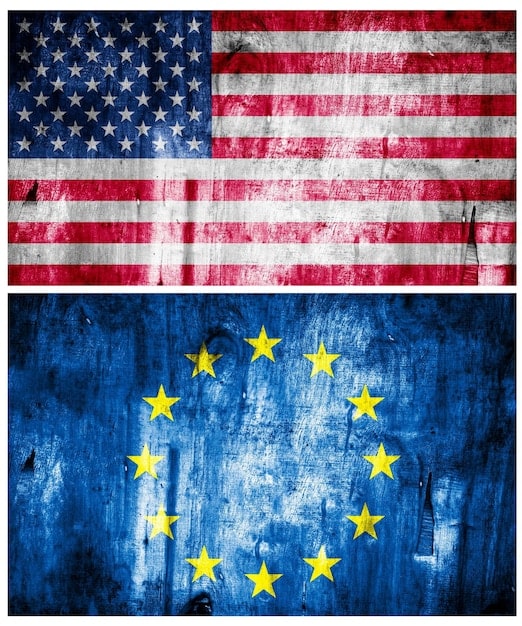Trump’s Foreign Policy & its Impact on US Overseas Businesses

The Trump Administration’s approach to foreign policy, characterized by protectionism and skepticism toward international agreements, significantly impacted US businesses operating overseas, forcing them to adapt to new trade barriers and navigate increased uncertainty.
The Trump Administration’s tenure was marked by a significant shift in US foreign policy, moving towards a more unilateral approach and challenging established international norms. This had profound implications for US companies operating overseas. But Trump Administration’s Approach to Foreign Policy: How Will It Affect US Businesses Operating Overseas?
Understanding the “America First” Foreign Policy Doctrine
At the heart of the Trump Administration’s foreign policy was the “America First” doctrine. This principle emphasized prioritizing US interests above all else, often leading to decisions that disrupted long-standing alliances and trade agreements. This approach had far-reaching effects on international relations and, consequently, on US businesses operating abroad.
Key Tenets of the “America First” Policy
The “America First” doctrine encompassed several key tenets, including protectionism, bilateralism, and a general skepticism toward multilateral institutions. Each of these elements played a role in shaping the administration’s foreign policy agenda.
Protectionism and Trade Wars
One of the most visible manifestations of the “America First” policy was the imposition of tariffs on goods imported from various countries, most notably China. This sparked a trade war that saw retaliatory tariffs from other nations, disrupting global supply chains and creating uncertainty for businesses.
- Tariffs on steel and aluminum imports
- Trade disputes with China over intellectual property and market access
- Renegotiation of the North American Free Trade Agreement (NAFTA)
- Withdrawal from the Trans-Pacific Partnership (TPP)
These protectionist measures led to increased costs for US businesses, as they faced higher prices for imported raw materials and components. Moreover, the retaliatory tariffs imposed by other countries made it more difficult for US companies to export their products, harming their competitiveness in the global market.
The “America First” approach also involved a preference for bilateral agreements over multilateral ones. The Trump Administration often sought to negotiate individual deals with countries, believing that this would give the US greater leverage. This strategy, however, complicated international trade relations and made it more difficult for businesses to navigate the global landscape.

The Impact on Global Supply Chains
The Trump Administration’s approach to foreign policy had a significant impact on global supply chains. The imposition of tariffs and trade barriers disrupted established trade routes and forced companies to rethink their sourcing and production strategies.
Disruptions and Realignment
The trade war between the US and China, in particular, led to significant disruptions in global supply chains. Many companies that had relied on China as a low-cost manufacturing hub were forced to seek alternative locations, such as Vietnam, India, and Mexico.
Increased Costs and Uncertainty
The disruption of global supply chains also led to increased costs for US businesses. Companies faced higher expenses related to relocating production facilities, finding new suppliers, and adapting to new regulations.
- Relocation of manufacturing facilities to avoid tariffs
- Diversification of supply chains to reduce dependence on single countries
- Increased costs associated with compliance and logistics
The uncertainty surrounding future trade policies also made it difficult for businesses to make long-term investment decisions. Companies were hesitant to commit to new projects or expand their operations, given the risk that trade policies could change at any time. This uncertainty hindered economic growth and innovation.
Furthermore, the Trump Administration’s approach to foreign policy strained relationships with key allies, such as the European Union. This made it more difficult for US businesses to operate in these markets, as they faced potential discrimination and regulatory barriers.

Navigating Regulatory Changes and Compliance
US businesses operating overseas also had to navigate a complex web of regulatory changes and compliance requirements under the Trump Administration. This included new export controls, sanctions, and investment restrictions.
New Export Controls
The Trump Administration tightened export controls on certain technologies, particularly those related to telecommunications and artificial intelligence. These controls were aimed at preventing China from gaining access to sensitive information and technologies that could be used for military purposes.
Sanctions and Investment Restrictions
The Trump Administration also imposed sanctions on individuals and entities that it deemed to be engaged in human rights abuses, corruption, or other illicit activities. These sanctions often targeted companies operating in countries such as Russia, Iran, and Venezuela.
- Compliance with the Foreign Corrupt Practices Act (FCPA)
- Monitoring of international sanctions and export controls
- Due diligence to ensure that business partners are not involved in illicit activities
Complying with these regulatory changes and compliance requirements proved to be challenging for US businesses. Companies had to invest in new compliance programs and hire experts to ensure that they were not violating any laws or regulations. Failure to comply could result in significant fines and penalties.
In addition, the Trump Administration’s approach to foreign policy created a more challenging environment for international arbitration and dispute resolution. The administration often questioned the legitimacy of international courts and tribunals, making it more difficult for businesses to resolve disputes with foreign governments and entities.
Adapting to Shifting Political Landscapes
The Trump Administration’s approach to foreign policy also required US businesses to adapt to shifting political landscapes in various countries. This included dealing with political instability, corruption, and human rights concerns.
Political Instability and Corruption
In some countries, political instability and corruption posed significant challenges for US businesses. Companies had to navigate complex political situations and ensure that they were not engaging in any corrupt practices.
Human Rights Concerns
The Trump Administration’s approach to human rights also had implications for US businesses operating in certain countries. Companies had to consider the human rights records of their business partners and ensure that they were not contributing to human rights abuses.
- Conducting human rights due diligence
- Engaging with local communities and stakeholders
- Promoting ethical and responsible business practices
Adapting to these shifting political landscapes required US businesses to be more proactive and engaged in their international operations. Companies had to invest in local expertise and build relationships with key stakeholders.
Moreover, the Trump Administration’s approach to foreign policy underscored the importance of corporate social responsibility. Companies were increasingly expected to address social and environmental issues in their international operations, and to demonstrate their commitment to ethical and sustainable business practices.
Strategies for US Businesses to Mitigate Risks
Given the challenges posed by the Trump Administration’s approach to foreign policy, US businesses needed to adopt strategies to mitigate risks and protect their interests. This included diversifying their operations, engaging with governments, and investing in compliance.
Diversification and Resilience
Diversifying their operations was one way for US businesses to reduce their exposure to political and economic risks. This involved expanding into new markets, diversifying their supply chains, and investing in new technologies.
Government Engagement and Advocacy
Engaging with governments and advocating for policies that support international trade and investment was also crucial. This involved working with industry associations, lobbying policymakers, and participating in public debates.
- Building relationships with government officials
- Participating in industry trade groups
- Advocating for policies that promote open trade and investment
Furthermore, investing in compliance programs and strengthening their risk management capabilities was essential for US businesses. This involved implementing robust internal controls, conducting due diligence on business partners, and monitoring international developments.
In the wake of the disruptions, US businesses have pursued various strategies. Many firms began to diversify their supply chains, seeking alternative manufacturing locations outside of China. Others invested in automation and technology to reduce their reliance on labor-intensive processes. Still others focused on developing stronger relationships with local partners in key markets, fostering resilience and flexibility in their operations. Each of these approaches reflects a broader effort to adapt to a more unpredictable and protectionist global environment.
Looking Ahead: The Future of US Foreign Policy and Business
The legacy of the Trump Administration’s approach to foreign policy will continue to shape the international landscape for years to come. While subsequent administrations may adopt different approaches, the challenges and lessons learned during this period will remain relevant for US businesses operating overseas.
The current administration has signaled a return to more multilateral engagement, focusing on rebuilding alliances and restoring confidence in international institutions. However, the underlying tensions and competition between the US and other major powers, particularly China, are likely to persist. This suggests that US businesses will need to continue navigating a complex and dynamic global environment, adapting their strategies to manage both opportunities and risks. Additionally, the ongoing focus on economic security and supply chain resilience will likely remain a priority, influencing policy decisions and business strategies alike.
| Key Aspect | Brief Description |
|---|---|
| 🌍 “America First” | Prioritized US interests, impacting trade and alliances. |
| ⛓ Supply Chains | Trade wars caused disruptions, forcing realignment. |
| 📜 Regulations | New export controls and sanctions increased compliance costs. |
| 🧭 Risk Mitigation | Diversification and government engagement were key strategies. |
Frequently Asked Questions
▼
Tariffs increased the cost of imported goods, disrupted supply chains, and led to retaliatory tariffs from other countries, harming the competitiveness of US businesses.
▼
The “America First” policy prioritized US interests above all else, leading to protectionist measures, bilateral agreements, and skepticism toward multilateral institutions.
▼
Tighter export controls on technologies aimed to prevent China from accessing sensitive information, impacting trade and global operations for many US tech companies.
▼
To mitigate risks, businesses diversified operations and supply chains, engaged with governments, and enhanced compliance programs to adhere to new regulations.
▼
Political instability and corruption in some countries posed challenges, requiring businesses to focus on ethical practices and proactively local stakeholder relationships.
Conclusion
In conclusion, the Trump Administration’s foreign policy significantly reshaped the landscape for US businesses operating overseas. By understanding these shifts and adapting accordingly, companies can navigate the complexities of the global marketplace and achieve sustainable success, and adapt. Furthermore, by diversifying supply chains, investing in emerging technologies, and engaging actively with the regulatory environment, US businesses can not only mitigate risks but also discover new avenues for growth and innovation in an ever-evolving global landscape.





